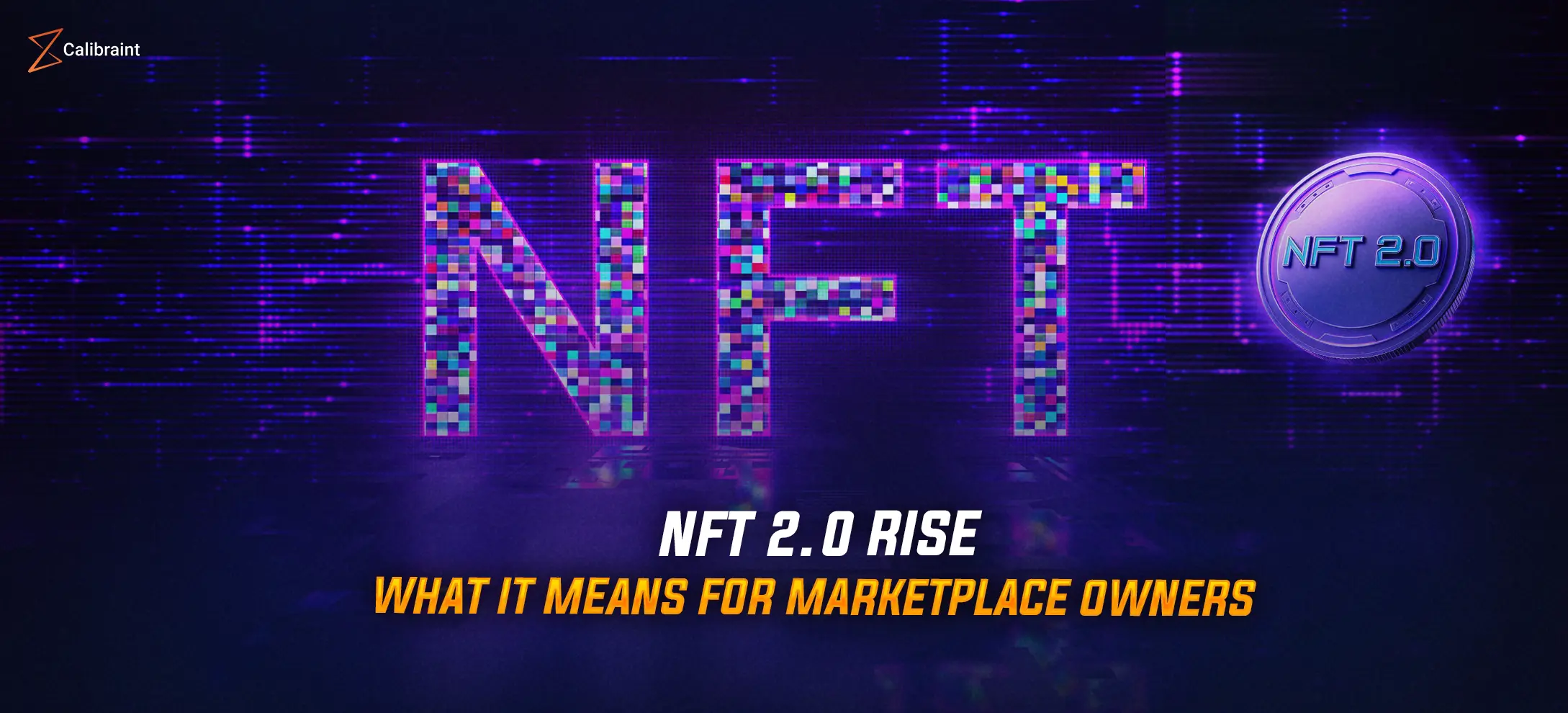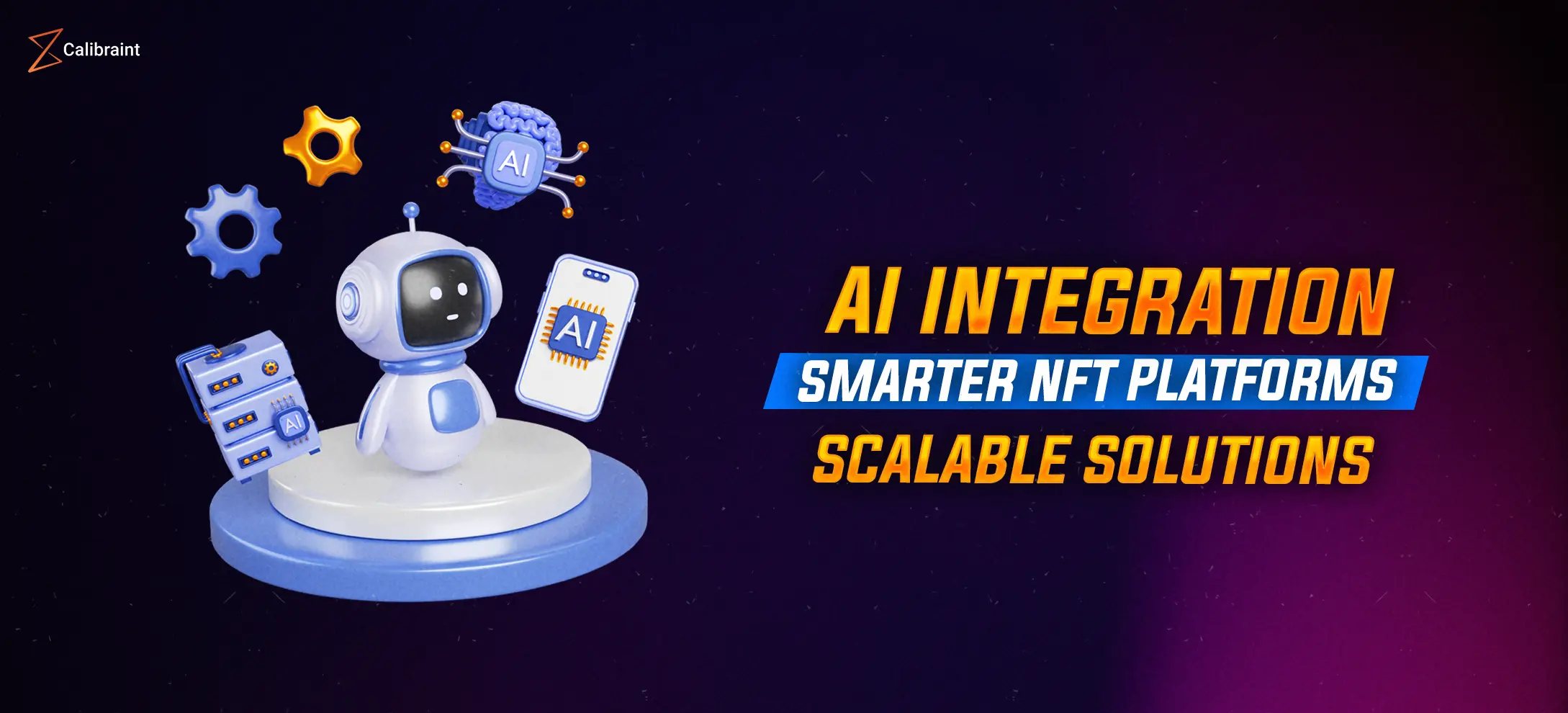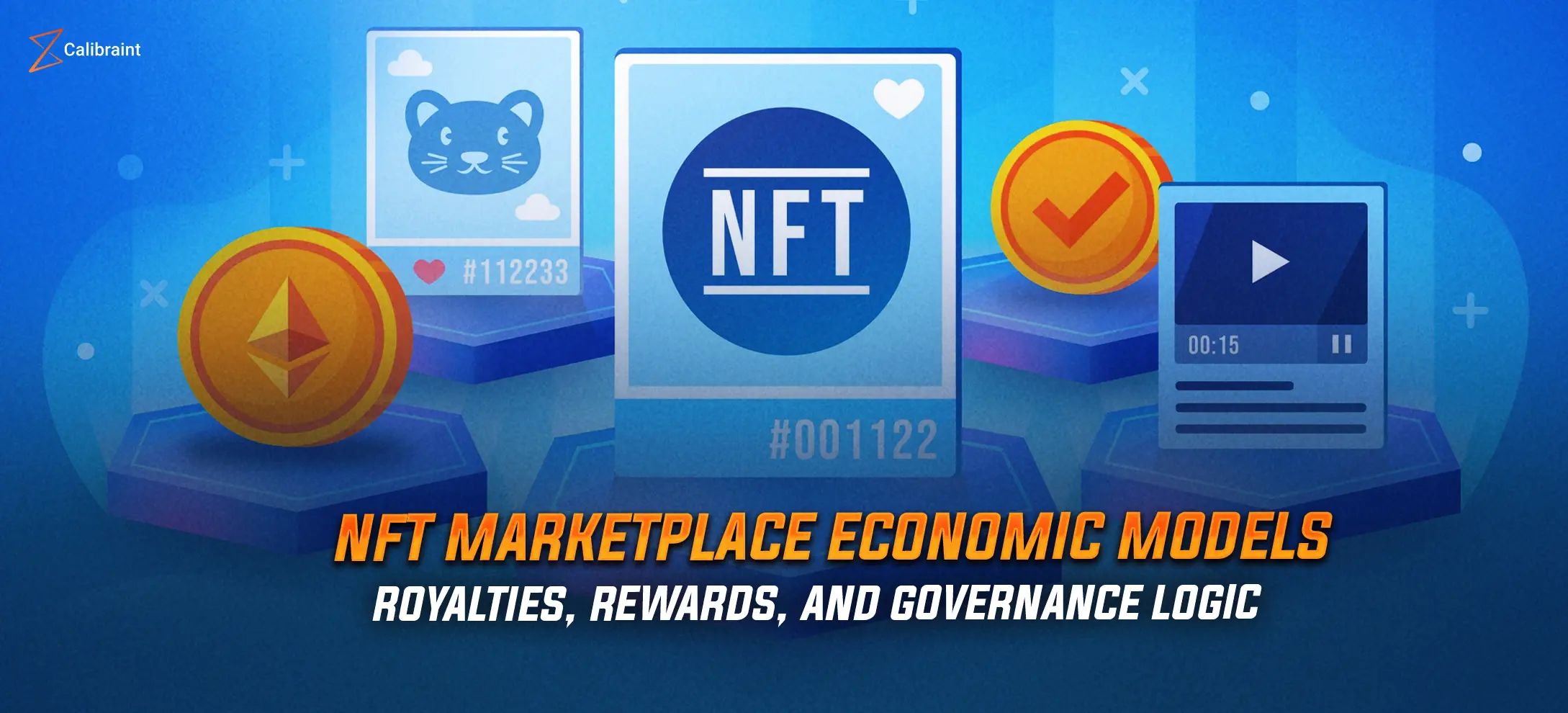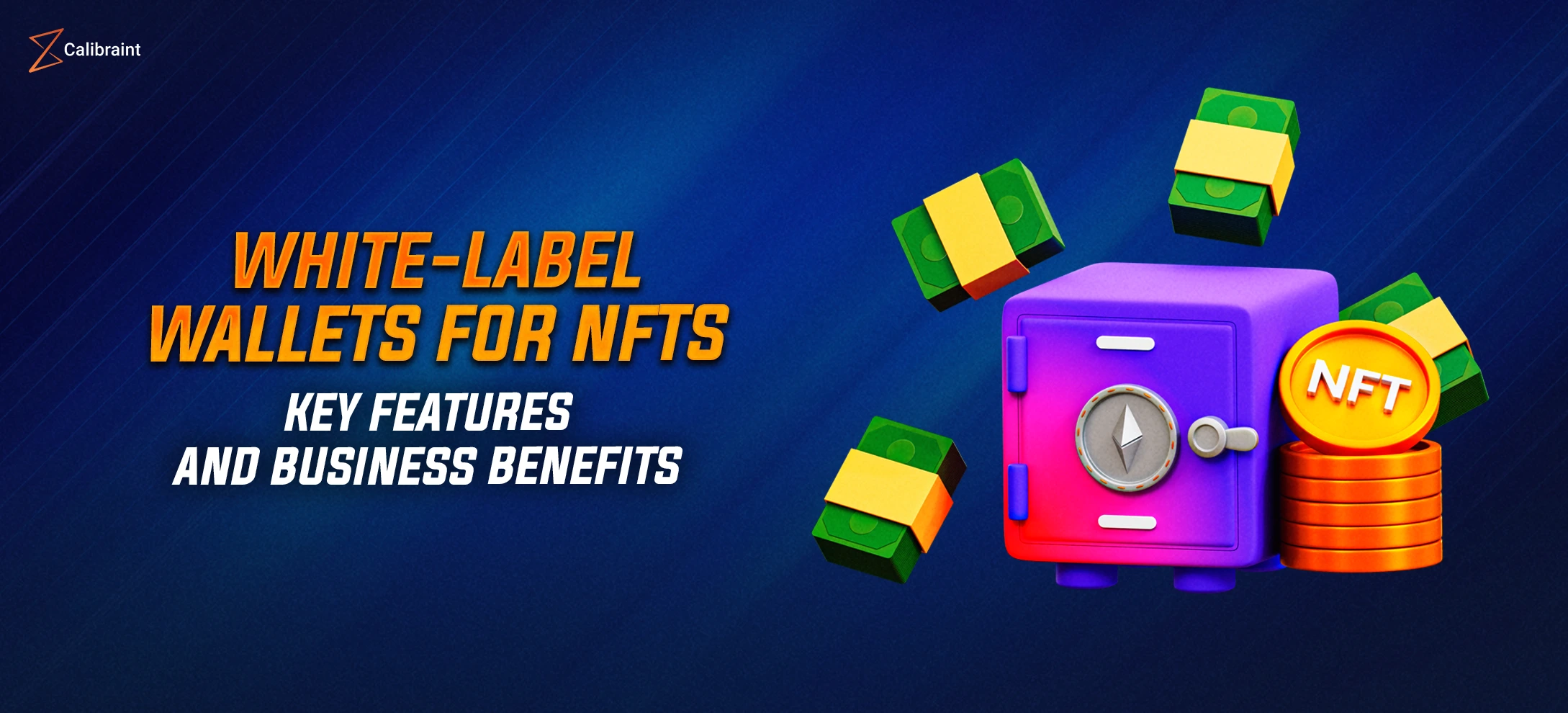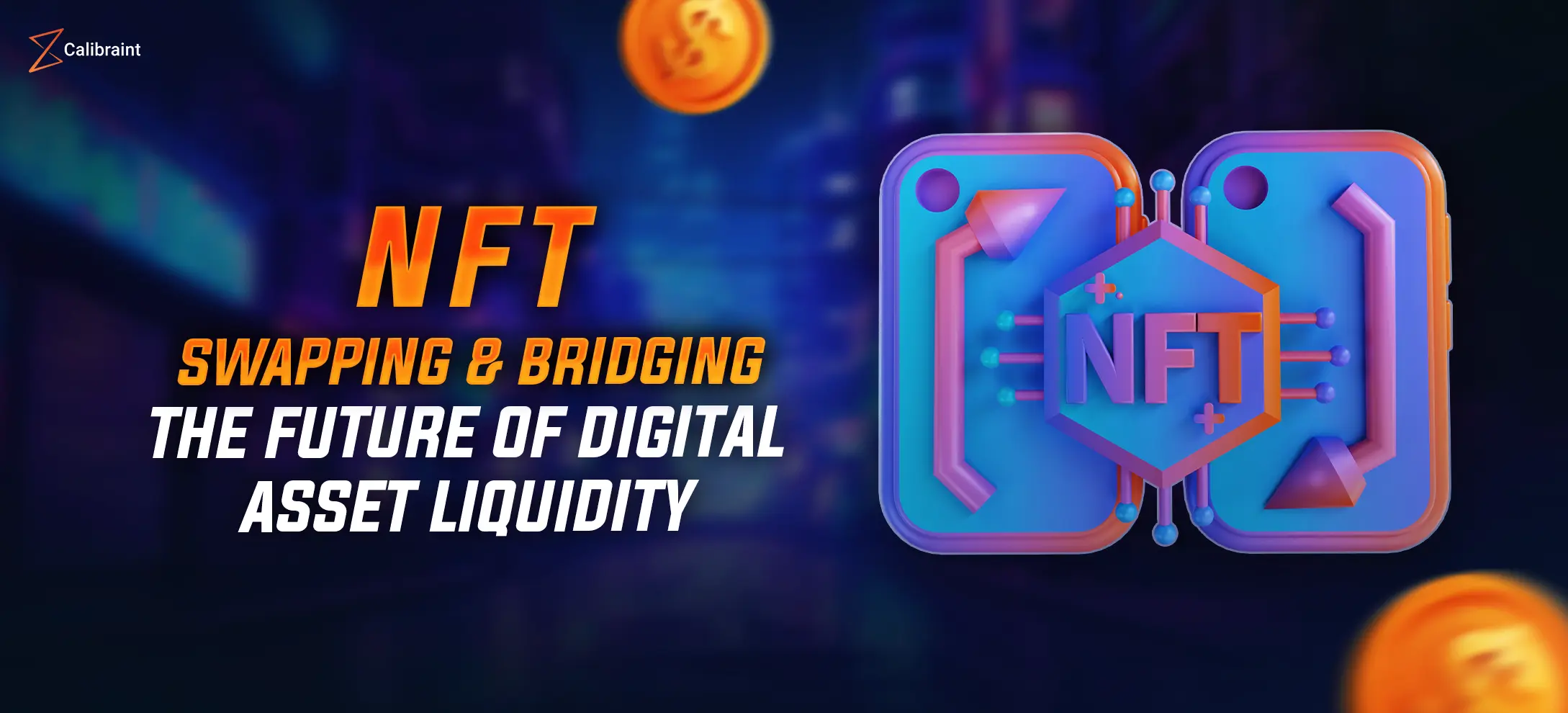Advanced Strategies for NFT Marketplace Architecture: Scalability, Security & Cross-Chain Innovation
Calibraint
Author
September 24, 2025
Last updated: November 14, 2025

NFTs have transformed from a cultural phenomenon into a thriving digital economy. What started as collectibles and art pieces has now evolved into enterprise-grade applications spanning gaming, real estate, fashion, music, and beyond. According to a report by Statista, the global NFT market size is projected to reach approximately $2.37 billion in 2024, with an annual growth rate of 9.10% through 2028
Businesses entering the NFT space often face critical questions:
- How can we design a platform that scales with millions of transactions?
- What’s the best approach to secure user data and digital assets?
- Can the architecture support cross-chain trades and next-gen features?
This blog dives deep into advanced strategies for NFT marketplace architecture, uncovering the core principles and technical layers needed to future-proof your platform.
The Building Blocks of Modern NFT Marketplace Architecture
Before we get into advanced strategies, let’s quickly ground ourselves in the fundamentals. An NFT marketplace typically consists of frontend layers, backend services, smart contracts, and blockchain infrastructure. To better understand the step-by-step process of launching a marketplace and the latest industry trends, you can check out our launch NFT marketplace guide & trends.
Frontend layer:
The frontend layer is the face of an NFT marketplace, where buyers, sellers, and creators interact with the platform. It includes everything from browsing NFTs, viewing collections, and exploring categories to placing bids and completing purchases. A well-designed frontend ensures smooth navigation, responsive performance, and an engaging user experience. It also incorporates wallet connectivity, profile management, and real-time updates for auctions or drops. In short, it’s the bridge between complex blockchain operations and a user-friendly interface.
Backend services:
Behind the scenes, backend services handle the heavy lifting that keeps the marketplace running seamlessly. These services manage APIs that connect the frontend to blockchain networks, enabling real-time data flow. They also cover order matching, transaction histories, notifications, and integration with multiple wallets. Scalable backend systems are essential to support high transaction volumes and peak-time surges, such as NFT launches. Without a strong backend, even the best-designed frontend will fall short of delivering a smooth user experience.
Smart contracts:
At the heart of NFT marketplace architecture lie smart contracts, which automate and enforce the rules of engagement. These contracts govern how ownership transfers occur, how royalties are distributed to creators, and how trades are validated. Once deployed on the blockchain, smart contracts operate without human intervention, ensuring transparency and fairness. However, they must be carefully coded and audited to avoid vulnerabilities that hackers can exploit. Their reliability forms the trust layer that makes NFT marketplaces credible and secure.
Blockchain layer:
The blockchain layer serves as the immutable ledger where every NFT transaction is recorded. It ensures authenticity, transparency, and permanence by storing critical details like ownership history, timestamps, and provenance. This layer provides the foundation of trust, making it impossible to alter or manipulate records. The choice of blockchain Ethereum, Solana, Polygon, or others directly impacts speed, scalability, and costs. For any enterprise-level marketplace, selecting the right blockchain is a strategic decision that shapes long-term growth and adoption.
While this seems straightforward, scaling and securing such a system at an enterprise level requires far more than the basics. That’s where advanced architecture comes into play.
Scalability: Preparing for High-Volume NFT Transactions
One of the biggest challenges for any NFT marketplace is handling massive user demand. Slow transaction speeds or network congestion can ruin user experience.
Strategies for Scalability:
- Horizontal scaling of backend services: By distributing workloads across multiple microservices, marketplaces can efficiently handle a surge in API requests. This ensures performance remains stable even during high-traffic events like NFT launches.
- Load balancing: Load balancers evenly distribute incoming traffic across servers, preventing bottlenecks. This is especially critical during NFT drops, where sudden spikes could otherwise crash the system.
- Layer 2 scaling solutions for NFTs: Techniques like rollups, sidechains, and state channels process transactions off-chain before final settlement. This reduces costs dramatically while improving speed and scalability.
- Caching and CDNs: By storing frequently accessed metadata and using content delivery networks, NFT marketplaces can load faster. This improves user experience, especially for marketplaces with large, image-heavy collections.
Imagine a gaming company launching 1 million NFTs as in-game assets. Without Layer 2 scaling solutions for NFTs, transaction fees would skyrocket, and users would face delays. With rollups integrated into the architecture, the marketplace processes thousands of transactions per second at a fraction of the cost.
Modular Smart Contracts: Flexible and Upgradeable
Traditional smart contracts are rigid, making upgrades difficult once deployed. In contrast, modular smart contracts are designed for flexibility.
Benefits of modular smart contracts in NFT marketplace architecture:
- Upgradeability: Modular smart contracts allow new features and functionalities to be added without interrupting ongoing operations. This makes the marketplace adaptable and keeps it relevant as user expectations evolve.
- Reusability: Individual contract modules can be reused across different NFT categories like art, real estate, or music. This saves development time and ensures consistency in how core marketplace functions operate.
- Faster Iteration: With modular design, teams can test new royalty mechanisms, fractional ownership models, or innovative features quickly. This enables faster experimentation and reduces the risk of locking into outdated systems.
This approach ensures the marketplace evolves with market demands while minimizing technical debt.
Cross-Chain Interoperability: Expanding Market Access
No single blockchain can dominate the NFT space forever. Ethereum remains a leader, but Solana, Polygon, Avalanche, and Flow are carving strong niches. To maximize reach, marketplaces must embrace cross-chain interoperability.
Approaches to cross-chain interoperability:
- Bridges: Blockchain bridges act as connectors that allow tokens and NFTs to move seamlessly between different networks. They reduce friction by enabling users to trade assets without being locked into a single ecosystem.
- Wrapped Assets: Wrapped assets let an NFT minted on one blockchain be represented and traded on another. This expands liquidity and gives creators access to broader audiences across multiple chains.
- Cross-Chain Smart Contracts: These smart contracts operate across different ecosystems, automating interactions like transfers or swaps. They make cross-chain processes efficient, secure, and less reliant on manual intervention.
Case example: A music NFT platform enables creators to mint NFTs on Ethereum while fans on Solana can buy them without leaving their network. This frictionless experience expands the creator’s audience and drives more liquidity.
NFT Infrastructure: Laying a Robust Foundation
The backbone of any marketplace lies in its NFT infrastructure. This includes APIs, indexing services, metadata storage, and wallet integrations.
Key pillars of NFT infrastructure:
- Robust APIs: APIs are essential for fetching NFT metadata, ownership history, and trade status in real time. They ensure seamless communication between the frontend, backend, and blockchain networks.
- Indexing Engines: Indexing engines organize and categorize NFT data for quick search and filtering. This allows users to browse large collections efficiently and improves overall marketplace responsiveness.
- User-Friendly Wallets: Integrating native or third-party wallets simplifies onboarding and enhances the user experience. It enables smooth transactions, secure storage, and easy access to NFT holdings.
- Analytics Dashboards: Analytics dashboards provide actionable insights into sales trends, royalty distributions, and user engagement. These insights help creators and marketplace operators make informed decisions and optimize strategies.
A solid NFT infrastructure doesn’t just keep the marketplace functional, it makes it adaptable to future innovations.
NFT Security: Safeguarding Assets and Users
Security is a top priority for both enterprises and individual users in the NFT ecosystem. High-profile scams, phishing attacks, and smart contract exploits have shown just how vulnerable digital assets can be without proper safeguards. Implementing advanced security practices is essential: conducting smart contract audits to identify vulnerabilities before deployment, using multi-signature wallets to add extra layers of protection for treasury funds, and ensuring end-to-end encryption to safeguard sensitive user data.
Additionally, real-time fraud detection monitors suspicious activity patterns, providing instant alerts and mitigating potential risks. For example, a marketplace with weak security could suffer a contract exploit that drains millions in assets, while a platform with layered audits and continuous monitoring prevents such attacks, earning long-term trust and credibility from its users.
Decentralized Asset Storage for NFTs: Beyond Metadata
While most NFTs store metadata off-chain, relying solely on centralized servers poses a significant risk to long-term availability and authenticity.
This is why decentralized asset storage for NFTs has become essential.
Solutions like IPFS (InterPlanetary File System) offer a peer-to-peer network for distributing files, Arweave provides permanent storage for “forever data,” and Filecoin uses a market-driven approach to ensure reliable, decentralized storage.
The importance of this infrastructure becomes clear when considering a centralized setup: if the server hosting an NFT art collection fails, the digital assets could vanish.
By leveraging decentralized storage, marketplaces guarantee that NFT ownership remains secure and accessible indefinitely, giving buyers confidence that their digital assets are truly permanent.
Layer 2 Scaling Solutions for NFTs: Driving Mass Adoption
We’ve touched on scalability, but Layer 2 scaling solutions for NFTs deserve their own spotlight. They are the backbone of mainstream adoption.
Common Layer 2 solutions:
- Rollups (Optimistic and ZK) – Batch transactions off-chain and settle on Ethereum.
- Sidechains (e.g., Polygon) – Independent chains compatible with Ethereum.
- State channels – Instant off-chain transaction processing.
By implementing Layer 2 scaling solutions for NFTs, marketplaces can offer:
- Near-zero gas fees.
- Instant confirmations.
- Seamless user onboarding for non-crypto natives.
Enterprise Use Cases: Where NFT Marketplace Architecture Shines
Advanced NFT marketplace architecture isn’t limited to art and collectibles. Enterprises across industries are adopting NFTs to streamline operations and engage customers.
Key enterprise use cases:
- Gaming – Tradeable in-game assets with low fees and instant transfers.
- Real estate – Tokenized property rights and fractional ownership.
- Fashion & luxury – Authenticating limited edition products.
- Music & entertainment – Direct-to-fan distribution with built-in royalties.
Case example: A luxury fashion brand launches an NFT marketplace for exclusive digital twins of their physical products. Built with NFT infrastructure, NFT security, and decentralized asset storage for NFTs, the platform ensures authenticity and preserves value across generations.
Conclusion: Building the Future of NFT Marketplaces
The next wave of NFT adoption won’t be driven by hype alone, it will be powered by robust NFT marketplace architecture that scales efficiently, ensures security, and supports seamless cross-chain operations. Enterprises aiming to succeed in this space must focus on scalable systems with Layer 2 scaling solutions for NFTs, flexible NFT infrastructure that adapts to evolving use cases, bulletproof NFT security to maintain user trust, and reliable decentralized asset storage for NFTs to preserve long-term value.
Designing a platform with these advanced strategies is no small feat, which is why partnering with experienced professionals is critical. Calibraint, a leading NFT Marketplace Development Company, specializes in creating enterprise-grade NFT marketplaces tailored to your business goals. From seamless scalability to state-of-the-art security and cross-chain interoperability, Calibraint helps turn your vision into a future-ready NFT platform that stands out in a competitive market.Take the next step in building your NFT marketplace connect with Calibraint today and bring your digital assets to life with confidence.
Calibraint
Author
September 24, 2025
Last updated: November 14, 2025






















